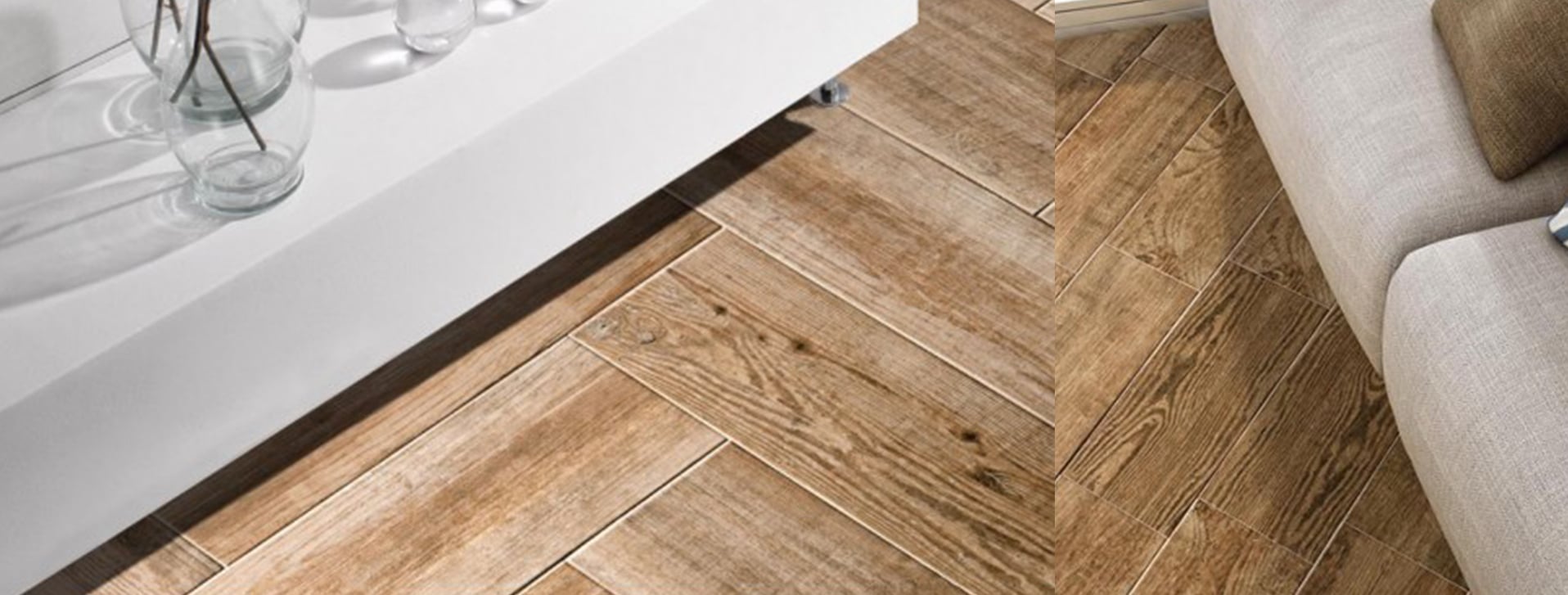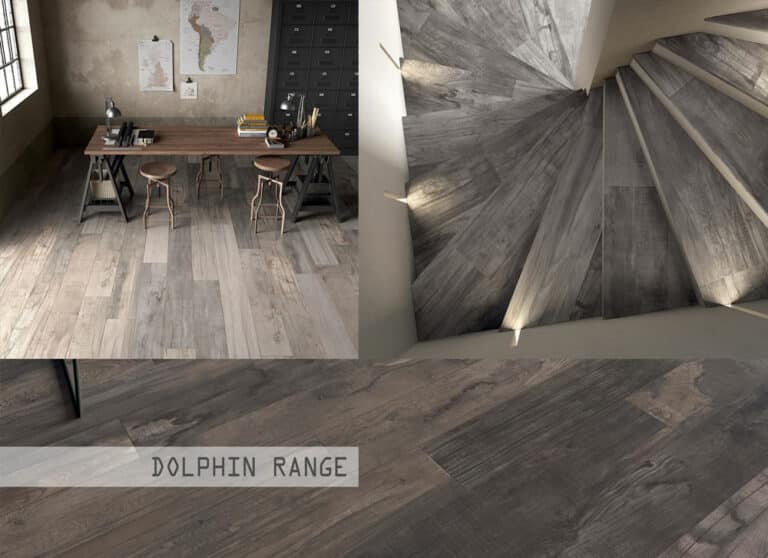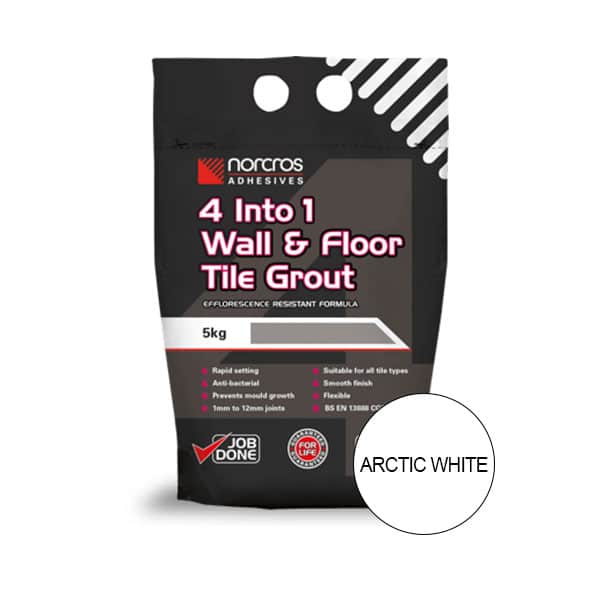Tile it right !
Ceramic tiles have been used since biblical times; they are hardwearing, easy to clean, water resistant, hygienic and very attractive. Even experienced amateurs used to hesitate at the thought of applying tiles, but the advent of modern tile cutting tools and adhesive now makes the job much easier. This easy step-bystep guide will give the inexperienced the courage to tackle the job and give those with more confidence some tips to avoid common mistakes. If you read this booklet carefully, use the correct tools and take your time, you will be able to achieve a high standard of tiling.
SELECTING YOUR TILES
There are several different types of tile available and they vary in their technical properties. It is essential that you select the correct tile for your situation.
GLAZED CERAMIC – Glazed tiles are the obvious choice for walls in bathrooms, kitchens and laundry areas. Glazed tiles are beautiful on conservatory floors and in reception rooms but are not suitable for outdoor use or heavy traffic floor areas.
PORCELAIN – Usually floor tiles. Extremely attractive and very hardwearing. Often glazed with good anti-slip qualities, they can be used inside or out.
QUARRY TILE – Made from natural clay, some are frost resistant and can be used for floors internally or externally. Their natural clay surface gives good slip resistance and they are extremely hard wearing.
MOSAIC – Small pieces of ceramic tile or glass usually sold in sheets on a mesh backing for ease of fixing.
WALL TILES
HOW MANY TILES DO YOU NEED?
First measure the walls to be tiled and calculate the area in square metres, work out the number of tiles per square metre and multiply this by the area to be covered – or ask our salesman to help with calculations.
Adhesive: 10 litres covers approximately 7 sq. metres of tiles. (This may vary depending on the key profile on the back of the tile)
Grout: 3.5 kg covers approximately 8 sq. metres of tiles (based on using a 150x150x5.5mm tile fixed with a 2mm joint).
WHAT DO YOU NEED?
AT LEAST:
- Spirit level
- Measuring tape
- 5 x 2.5cm (2″ x 1″) battens for marking out tiles
- Tile cutter
- Pincers for nipping off the edges Adhesive spreader
- Grouting squeegee
- Sponge Spacer pegs
- Tile saw may be required for natural stone products, limestone, marble, granite slate etc.
THESE ACCESSORIES WILL MAKE A MORE PROFESSIONAL JOB:
- Tile edge profiles (available in coloured PVC and metals)
- Bath/workshop seal
- Pre-formed movement and control joint profiles
PREPARATION
You will need a perfectly flat surface for tiling. Do not cut corners – preparing the surface is vital.
- New plaster should be left for 4 weeks and be thoroughly dry before tiling. Old plaster is suitable, provided it is sound.
- Plasterboard is suitable for walls provided it is well supported with the board being a minimum of 12.5 mm.
- Painted surfaces. It is very important to make a detailed examination of the surface, as the permanent success of the installation is dependent on good adhesion between the paint and the surface to which it has been applied and between any substrate and basic structure. Remove any old wall covering and flaking paint. Fill in old cracks and voids with filler. Ensure the surface to be tiled is smooth, clean and free from dust, dirt or grease.
SETTING OUT
Planning ahead is essential for a good result.
Along a length of timber, mark the tile widths to help you identify where the tile will start and finish, remembering to leave space for the joints, which must be at least 2mm wide.
Set out horizontal position of the tiles so that the same size cuts are made either side of windows etc. Avoid small difficult cuts as they can spoil the appearance. Plan each wall carefully, remembering that any patterns/designs will need to be matched in the corners of the room. For plain tiles each wall should be centralised avoiding any small cuts.
OFF YOU GO
- Find the lowest point of the base you are working to (skirtings, bath top, work surface etc.) with a spirit level.
- Place a tile against the lowest point and draw a line on the wall along the top of the tile. N.B. The start point of the line will depend on the setting out of the tiles, as the tile against the floor may be a cut tile.
- Nail the batten along the wall to this line. Use the spirit level to ensure it is level. The first line of tiles will rest on this batten.
- Draw a vertical (plumb) line at one end of the wall, one tile width away from the edge. Use this to check that the tiles are in line vertically.
ADHESIVES
There are many different types of adhesive available. As all conditions vary, it is most important that you seek advice so as to use the correct type. Always follow the manufacturer’s instructions.
- Spread the wall tile adhesive using a notched trowel or spreader onto the wall. Work in small areas of about 1 sq. metre at a time, so that tiles are fixed before the surface of the adhesive forms a skin. Press and twist the wall tiles into the adhesive starting at the bottom and working upwards, one row of who le tiles at a time, using spacers (if required) to ensure a uniform joint. Check the horizontal and vertical lines with the spirit level every few rows.
- Remove surplus adhesive from tile surfaces with a damp sponge, and from joints to allow room for grout. When the adhesive has set, remove the batten and complete the tiling.
- When tiles need to be cut, ask one of our salesmen for a demonstration of the various tools available. There are tile cutters and tile pincers that will help to achieve professional results.
- In awkward locations it is often easier to apply the wall adhesive onto the back of the tile instead of the wall. For complicated shapes use cardboard to make a template and transfer the design to the tile.
- If the tile does not have a glazed edge, a neat finish on external edges and corners can be achieved with the use of tile edge trim incorporated at the time of tiling. To prevent the seepage of water around baths and basins, a plastic sealing strip or silicone sealant should be used.
GROUTING
Do not begin grouting for at least 12 hours after fixing. There are many types of grout, so ask our salesman for the correct grout for your application, especially when using highly glazed tiles. Force the grout into the joints using a flexible spreader or grouting sponge. Do not use steel or hard rigid spreaders as these can cause scratching to certain tile glazes. Remove surplus grout from the surface with a sponge and ‘peg’ the joints with a rounded stick to achieve an even finish. Polish with a dry cloth.
Floor Tiles
PREPARATION
Time spent on proper preparation makes the fixing easier, quicker and ensures a better finish.
TILING ONTO CONCRETE
New concrete must be at least six weeks old and thoroughly dry before fixing ceramic floor tiles. The surface must be smooth, flat and free from dirt and grease. Uneven surfaces can be improved with levelling compound.
TILING ONTO WOODEN FLOORS
Existing wooden floors must be rigid, stable and capable of supporting additional load without flexing and have sufficient ventilation beneath them. There are two basic alternative methods to follow:
- Overlay the existing timber with 15mm exterior grade plywood, which has been sealed. Fully screw down the plywood at 300 mm intervals ensuring all junctions are supported by noggings or joists. Use a flexible adhesive.
- Overlay the existing timber with special plastic sheeting and use a flexible adhesive .
A flexible grout is recommended with all of these methods. There are many factors to consider when deciding which method is best suited for your particular circumstances. It is important to seek professional advice.
TILING ONTO VINYL TILES
Existing vinyl tiles must be free of grease, polish etc., and firmly adhered to the subfloor. The surface of the vinyl tile must be primed and allowed to dry before spreading the adhesive. Also an additive may be used with the adhesive.
TILING ONTO EXISTING QUARRIES, GLAZED AND UNGLAZED TILES
Existing tiles must be clean, grease free and firmly adhered to the subfloor. An additive should be used with the adhesive and grout when tiling onto glazed tiles.
SETTING OUT
Planning ahead pays dividends, so spend time on the following:
– Laying ceramic floor tiles will raise the level of the finished floor, so if possible remove all fixtures before tiling. Mark a chalk line on the floor down the centre of the room parallel to the most suitable wall (normally this is achieved by viewing the room from the doorway). Lay the tiles down this line and then work towards the wall you think is best, leaving a joint between the tiles of at least 3mm. Tile spacers can be used to achieve a uniform size joint. Avoid small cuts, as they can be difficult to cut and do not look professional.
CUTTING TILES
Floor tiles are generally harder to cut than wall tiles. Modern tools make the cutting of most types of ceramic tiles simple. Ask one of our salesmen for a demonstration of all the various aids available.
Use Rapid or Normal setting adhesives. Always consult one of our salesmen for detailed advice and follow manufacturers’ instructions. Mix the adhesive as per manufacturer’s instructions and spread with a solid bed trowel onto the surface to be tiled. Lay each tile into the adhesive firmly with a slight twisting motion to ensure a solid bed and prevent voids under the tile. Remove surplus adhesive from the tile surface with a damp sponge or cloth. Work in small areas of about 1 sq. metre at a time so that tiles are fixed before the surface forms a skin. Every so often use a spirit level or straight edge to check that the tiles fixed are flat. Remove and adjust the amount of adhesive to achieve a flat surface, but don’t leave it too late or the adhesive will set. Leave floor to set before grouting (usually 24 hours unless using a rapid set adhesive).
In bathrooms, special attention should be paid to sealing the gap between wall and base, particularly where the location is on a suspended floor. An additive should be used with the adhesive when fixing fully vitrified tiles such as porcelain.
GROUTING
Do not begin grouting or walk on the floor tiles for at least 24 hours (unless using a rapid set adhesive) to avoid the chance of disturbing the tiles before they have bonded completely with the adhesive. There are many types of grout so ask one of our salesmen for the correct grout for your application. Force the grout into the joints using a spreader. Remove surplus grout from the surface with a sponge and peg the joints with a rounded stick to achieve an even better finish.
Note:
– When grouting tiles on a timber floor, use a water-based polymer admixture to improve flexibility.
MOVEMENT JOINTS
These joints are 6/8mm wide and filled with flexible filler, which allow for movement and prevent tile damage. They are normally installed where flooring abuts wall, steps, columns etc., on large floor areas and over structural movement joints. Floors less than 4 metres between walls will not normally need movement joints.
MAINTENANCE
With proper care and attention, a correctly installed, good quality ceramic floor tile should give many years trouble-free service. Grit is the biggest enemy of any floor material and a mat adjacent to external doors is strongly recommended. Ask one of ours salesmen for details, as there are numerous maintenance products on the market. Some terracotta, natural stone and slate tiles may need resealing.








